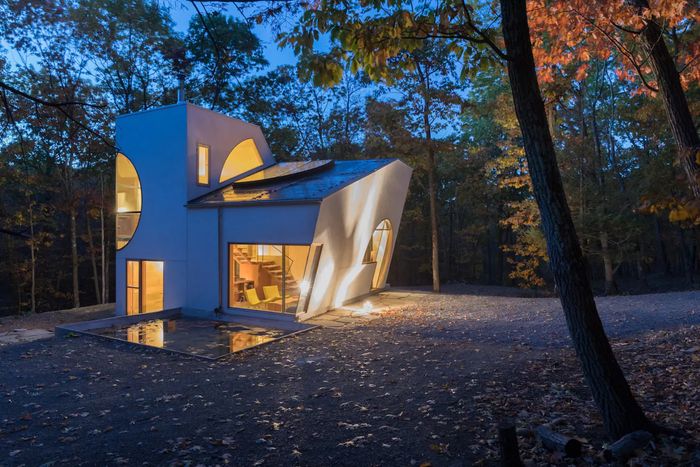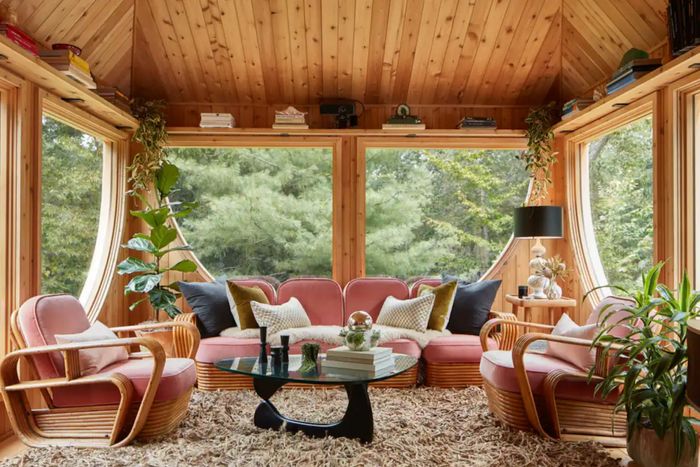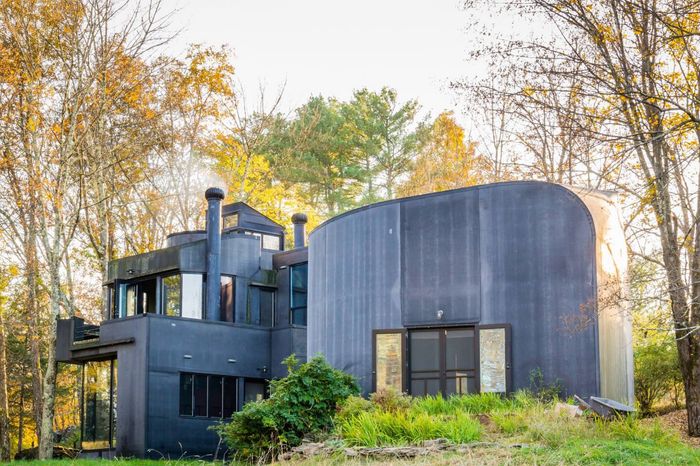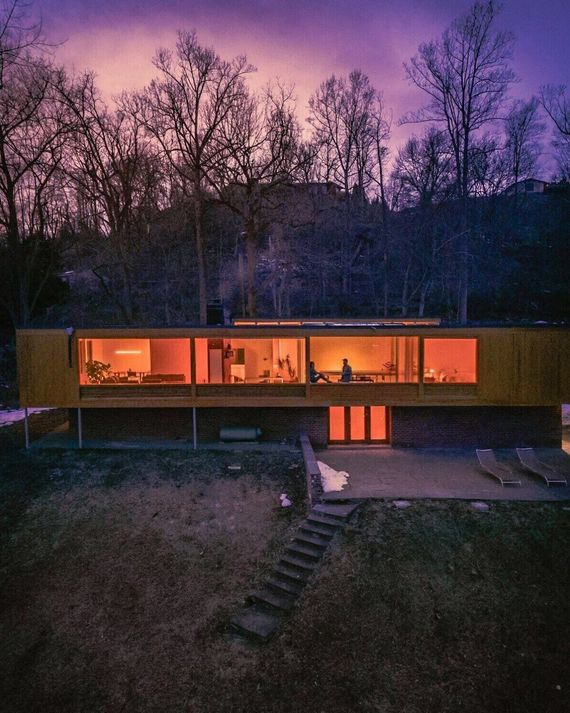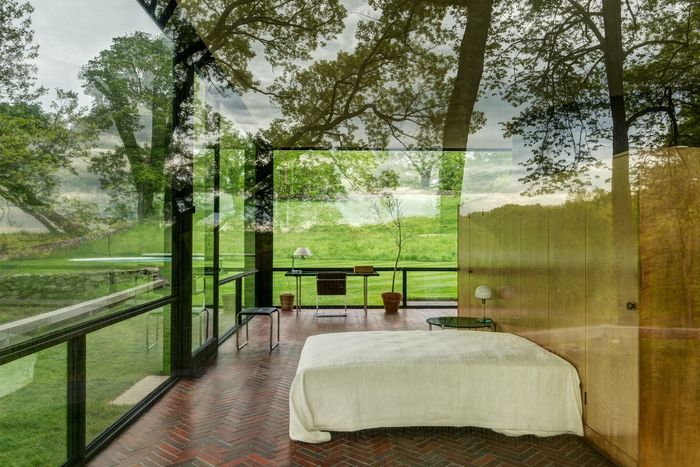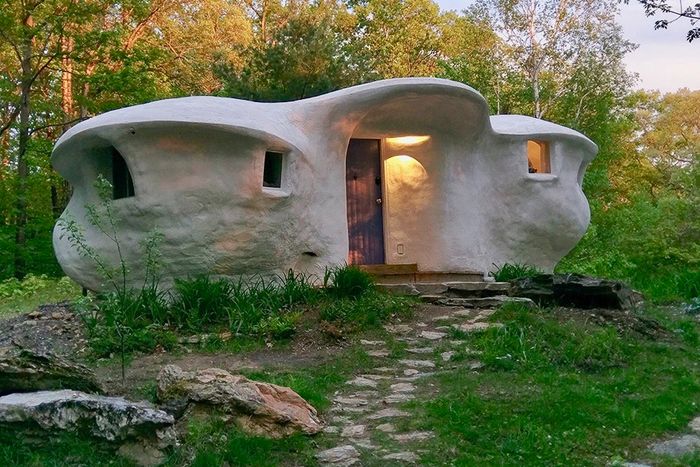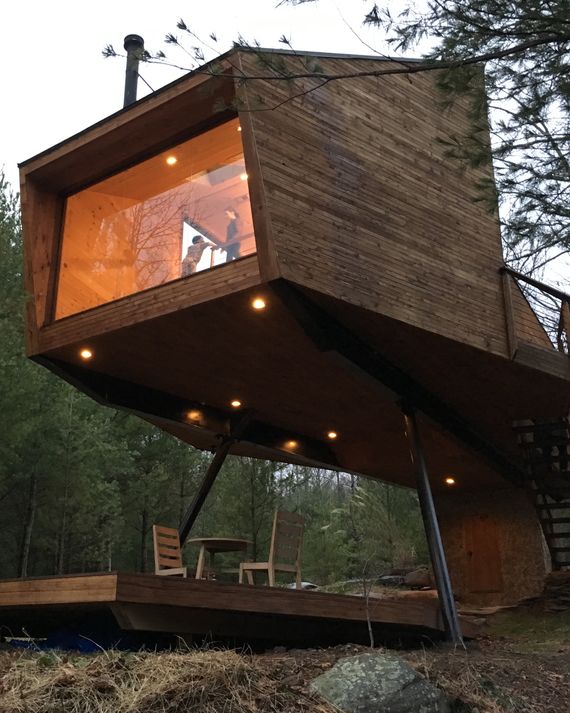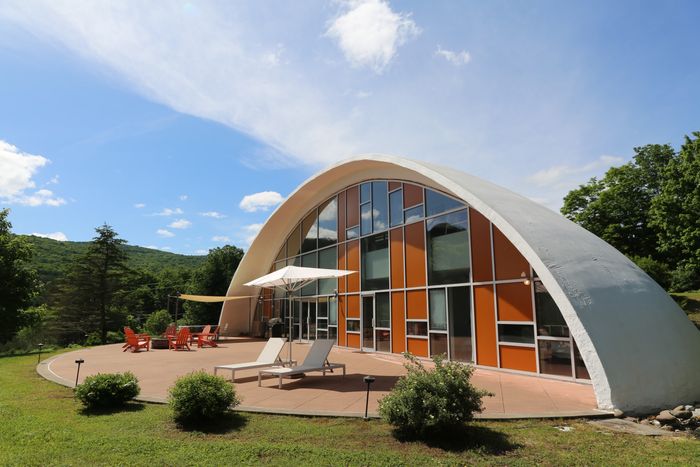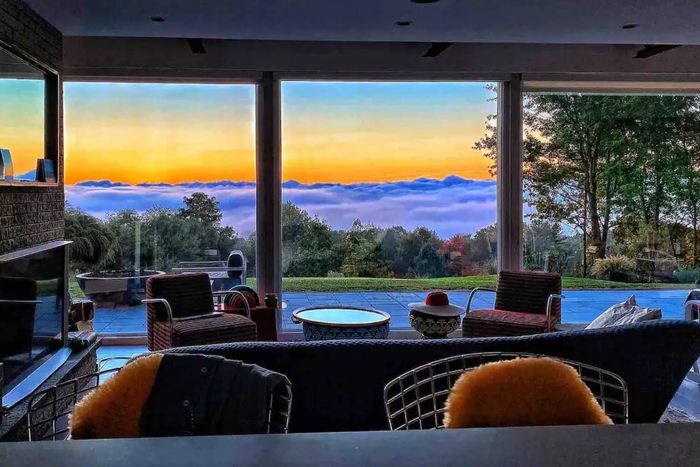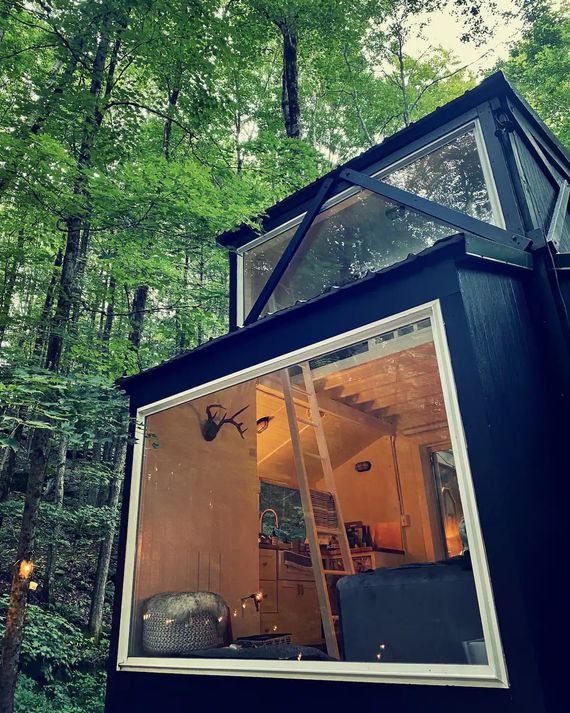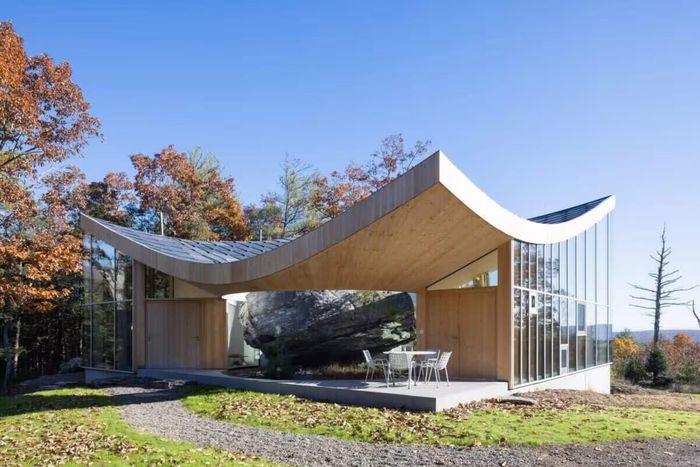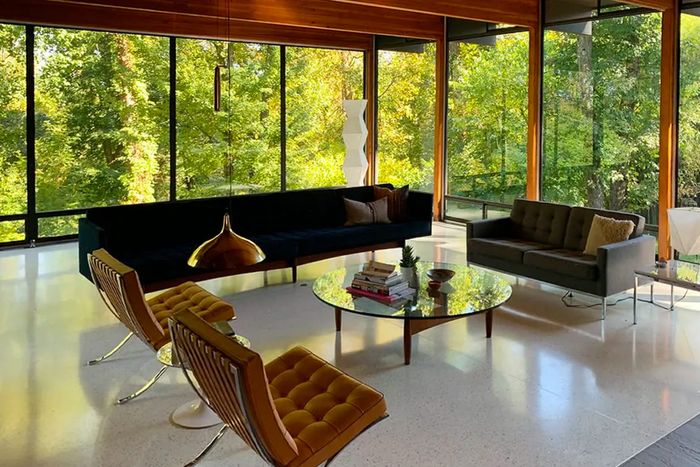Architecturally Stunning Short-term Rentals Near NYC

The treehouse in Willow, New York.
Photo: Airbnb
For most people, the only way they’ll ever get to spend any time in an architecturally significant house is on a guided tour. That’s hardly enough to get a sense of what it would be like to wake up and make coffee there in the morning, hang out in the living room, or watch the daylight move through the rooms. But with so many designers and patrons of avant-garde architecture in New York, there are dozens of architectural masterpieces available for a short-term rental within a few hours’ drive. (And it’s a boon to the rest of us that these design lovers so often buy — or build — such properties as second homes.) The sleeping arrangements are sometimes strange, and the prices are often considerably higher than the workday rentals out there, but the houses themselves look like they might rearrange your synapses — an experience you can prepare for, if you like, by reading the reviews before you book. Here are some of our favorites, all within about a three-hour drive of New York City.
Steve Holl’s open-plan Ex of In House.
Photo: Airbnb
The open-plan Ex of In House was designed by Steven Holl (known in New York for his critically acclaimed, accessibility-challenged library in Queens) and completed in 2016. By now, it’s nearly a classic on Airbnb (it has more than 250 rave reviews), but it began as a two-year architectural manifesto that Holl ended up renting out to fund the architectural nonprofit he runs nearby. Located on a 30-acre reserve, the house is airy with high ceilings and lined in mahogany and birch plywood. With its cutouts, angled walls, and rounded alcoves, it has an unpredictable rhythm that comes from a design of “spherical spaces intersecting with tesseract trapezoids,” according to Holl. In practice, that translates into no bedrooms, but the nearly 1,000-square-foot space can sleep four on organic Japanese futons. Holl designed the house to be responsive to the landscape, and it runs on solar power, geothermal energy, and a wood stove during the winter. The experience leans more cool than comfy: There are warnings about the heat upstairs during certain months and the hardness of the futons. But as some guests shared, it’s still a house you would cancel plans for. Rents in August for around $500 a night.
The Antler House, as shown in listing photos, is one of the few playful mid-century Andrew Geller beach houses that still exist.
Many of the modest but exuberant Hamptons beach houses designed by mid-century architect Andrew Geller have been demolished, but this delightful cedar-lined house in the Springs is one of the few that’s still standing. Geller referred to his cheerful, inexpensive designs as “summer-use playhouses,” and this house’s trademark is a loft framed by floor-to-ceiling owl-eye windows. The rest of the 1968 home is just as charming, with soaring cathedral ceilings, triangular flaps with peekaboo views, and hideaway nooks. And the kitchen is a dream, with a jade-tiled wall and wide knotty-pine floors. Like Holl’s house, this one has a small footprint and totals just about 1,200 square feet. The house wasn’t always in good shape, but the previous owners, with the help of Two Street Studio and Geller’s grandson, recently undertook a historically sensitive and highly detailed renovation (for which it won a preservation award in 2020). The home sold this spring — the buyer was reported to be New York Times columnist Maureen Dowd — but for now, it’s still on the short-term rental market. There’s no pool, but it’s a few blocks from Louse Point Beach and has a large elevated deck. And if it happens to rain, there’s a 120-inch movie screen and a 4K projector. With two bedrooms, two bathrooms, and a modern HVAC system. Rents for around $1,500 a night.
The Rubber House, as shown in listing photos, has a neoprene exterior that helps it blend into the upstate New York landscape.
Photo: Airbnb
This architectural case-study house — the first home by landscape architect Tom Pritchard — was designed for the choreographer Eugene Loring in 1981 and owned by actor Willem Dafoe for two decades. Pritchard covered the house in a dark-gray neoprene (hence the name), a material normally used to coat flat industrial roofs, but in this case, it’s said to provide superior sound quality for musicians. The house has an adjacent dance studio (one of its owners is a professional ballerina), but it’s not included in the rental because it is undergoing a renovation. Nestled amid moss-covered boulders by the Mohonk nature reserve upstate, the house has a vaulted, open kitchen (Loring’s partner was a chef), a glass atrium, and a writer’s tower, and it’s full of pleasing, multicolored volumes and cool angles, like a 3-D Cubist painting. But its 270-degree views from the main bedroom are perhaps what makes it feel like a real escape into the woods; as Dafoe wrote in Interview magazine, “My best memory of the place is lying in bed, watching a storm roll in from over the horizon.” Rents for around $850 a night. The Airbnb listing also invites artists to stay for residencies or use it for projects, and to contact the host for subsidized rates.
Philip Johnson’s Wolfhouse has striking Hudson River views.
Photo: Vrbo
Most people have heard of Philip Johnson’s Glass House in New Canaan, Connecticut, but his lesser-known Wolfhouse in Newburgh went up the same year, in 1949. Instead of rolling meadow views, it offers the Hudson River from its perch on a hillside above the river, as Ruth Wolf, the original owner, requested. This modernist four-bedroom, three-bath home had been altered (and carpeted, gasp!) by previous owners, but it was carefully restored a few years ago by two friends, Jeremy Parker, a creative director, and Jiminy Ha, head of graphic design at the Guggenheim. They bought it a week before the pandemic shutdown, then spent the following four years restoring it, painstakingly sourcing historically accurate finishes, vintage furniture, and reused materials. They also wanted to acknowledge Johnson’s complicated history as a Nazi sympathizer and gay man and decided to make it a cultural center of sorts, welcoming LGBTQ+ artists like themselves by hosting workshops and events for the community in Newburgh. Rents for around $1,450 a night. No pets or kids allowed — common in many of these architecturally notable properties.
Philip Johnson’s Glass House is a museum, but it allows overnight stays.
Photo: Michael Biondo
For those who prefer the cultural cachet (and have a lot of cash), they can always rent the Glass House in New Canaan, Connecticut, now a museum operated by the National Trust for Historic Preservation. Though it’s not available on any short-term rental sites, you can spend the night there by booking directly with the museum. Visitors can opt to sleep in either the 1,728-square-foot Glass House or the newly restored brick house, where Andy Warhol was once a guest. (While the brick house was ostensibly for guests, Johnson and his partner often liked to sleep there when no one was visiting. Also, it has an epic bedroom). It’s just going to set you back $30,000 a night. Only two overnight guests are allowed, but visitors can host up to ten others for dinner. All proceeds will go to the Trust.
The charming Owl Hill House is near the Berkshires and Bennington.
Photo: Airbnb
Built by a group of local sculptors in the early 1980s (and recently restored by one of them), Owl Hill House is an organically shaped, hand-plastered house with built-in furniture and definitely looks like a house where hobbits would live (guests have nicknamed it the Mushroom House). At 570 square feet, with one bedroom and one bath, the house is cozy, a storybook cottage (there’s even a stone path leading up to the front door) that tops out at two guests. It rents for about $250 a night and is located down a quiet semi-private road. Near Bennington, the Berkshires, and Mass MOCA, the drive from the city is just over three hours.
This tree house has huge windows and a cedar hot tub.
Photo: Airbnb
This striking, angular home jutting out over a pond in the foothills of the Catskills was designed by British furniture and interior designer Antony Gibbon and built by local woodworker William Johnson. The family who dreamed it up told T Magazine that they were taken with Gibbon’s (mostly unbuilt) designs that seemed to blend into their surroundings. This tree house is all about experiencing nature: ten uncurtained windows, some of them 12 feet wide, look out onto eastern white pines and oak trees. Gibbon told Dwell the design “pushed away from 90-degree corners as much as possible.” There’s a sleeping loft accessible via a ladder, but it’s not entirely rustic: There’s a wood-fired cedar hot tub and a modern kitchen. It shares a swimmable pond with the family’s main house, about a five-minute walk away. With no Wi-Fi or cell service, it seems ideal for anyone looking for a social-media cleanse. The rate in September — the soonest it’s available — is $375 a night.
The Shell House is a concrete half-dome with a wall of windows and porcelain panels.
Photo: Airbnb
Architect Seymour Rutkin built this concrete half-dome in the Catskills for himself in 1996 and lived there for the rest of his life (he died in 2007). Unlike many other dome homes, this one is not of the hippie geodesic variety, and the arched wall of windows and insulated orange porcelain panels give it a very contemporary feel. There are mountain views throughout the house and a 2,000-square-foot patio and firepit outside. The Brooklyn family who bought the three-bedroom, two-and-a-half-bath home hired DAAM to do a high-end, award-winning renovation, adding a mahogany-lined kitchen that mimics the building’s curves. This house is also pet-, child- and remote-work friendly. Rents for around $600 per night.
Hillcrest House was originally built in 1952. The current owners hired Jeff Jordan Architects to open up the floor plan and the flow between inside and out.
Photo: Airbnb
Newburgh apparently has a number of striking hilltop glass houses with Hudson River views. This one, originally built in 1952, is a two-bedroom with a hot tub, sleek kitchen, and some very stylish furniture. The owners hired Jeff Jordan Architects to open the home’s floor plan and relationship with the exterior, expanding the size of the windows and adding sliding glass doors and cedar walls indoors and out. HVAC, a wood-burning stove, and an outdoor firepit make this a good option for cold-weather rentals as well as summer ones. Rents for about $935 a night.
Huska Creek Cabin is one of the few (maybe only) remaining DIY “bolt-together” houses from the 1970s.
Photo: Airbnb
Huska Creek Cabin, as it’s called, is one of the few (or maybe only) remaining DIY “bolt-together” houses designed in the 1970s by architect Jeffrey Milstein. The tiny, inexpensive cabins (they cost about $20,000 to build in today’s dollars, inclusive of materials and appliances) were designed to be taken apart and moved if their owners didn’t own the land they were built on. Plans were sold through Family Circle magazine, which hired Milstein in an attempt to hop onto the ecoconscious DIY home-building trends of the era. A British couple, whose purchase and renovation was covered in the New York Times, bought this one a few years back. Like a few of the cabins on this list, this one has a distinct blocky profile and giant windows that look out onto a wood deck that feels more like a stage. Situated near a creek on 6.5 acres, it rents for about $285 a night.
Rock N’ House was built around a huge glacial boulder that was on the property.
Photo: Vrbo
Built around a giant glacial boulder that was located on the property, this modern home, designed by Swiss architect Christian Wassmann for his family, looks like the lair of a Nordic god. The home has four bedrooms and 3.5 baths, a sunken living room, and a dining table with space for ten, making it a good option for a group of friends. It’s located between Saugerties and Woodstock on 14 acres, down a secluded road with panoramic views. The roof’s shape, according to a story in Architectural Digest, is optimized for maximum sun, and inside a hollow railing doubles as a viewing device to locate Polaris. The cost averages $1,170 per night.
This mid-century home, as shown in listing photos, was designed by Gerald Luss, who also did the interiors of the Time-Life building.
Photo: Boutique Homes
The influential mid-century architect who designed the interiors of the Time-Life building built this home for his family in 1952. Not only is it Mad Men–era, it’s located in the town where Don Draper supposedly lived and has some of the original furnishings, including the 12-foot-long sofa and coffee table Luss designed for Time-Life. Cantilevered with a huge stone hearth, the current owners (who ended up becoming friends with Luss after moving in) have kept it looking like something of a time capsule. The staircase, which appears to be free-floating; the upward-swooping roofline; and the opening made for the boulder all give the home a sense of drama. Located on two acres in a neighborhood of other notable mid-century homes and near a local lake, it’s off the Metro-North. Starts at $550 a night.
Source link

